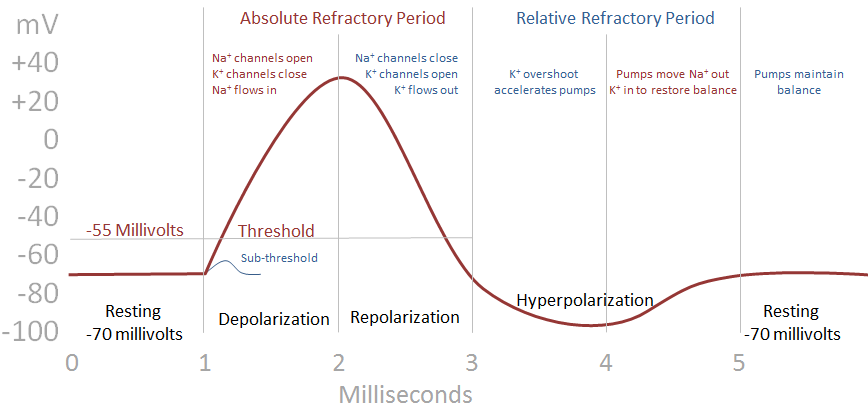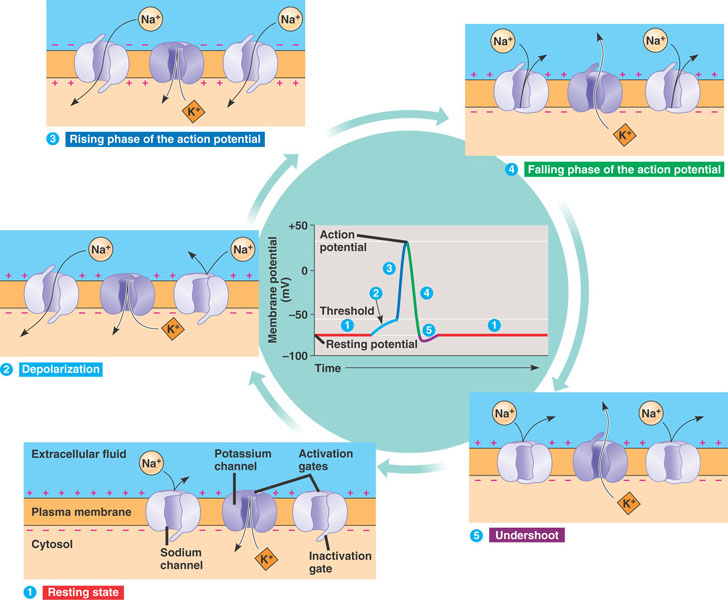06 Jan Excitation and Inhibition
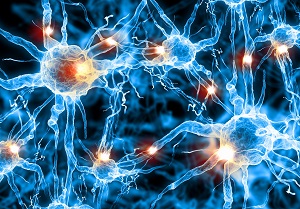 Most, if not all, neural information-processing functions involve the flow of action potential. Impulses in the nervous system are changes in the action potential or electrical charge of membranes. It is possible that, in addition to the membranes, the potential within the cytoplasm of the cell changes as a result of electrical flow in neurons. Potentials generally flow in one direction, from axons across synapses to dendrites, cell bodies, or other axons. Reverse transmission across synapses does not occur, although inhibitory responses can dull the effects of impulses.
Most, if not all, neural information-processing functions involve the flow of action potential. Impulses in the nervous system are changes in the action potential or electrical charge of membranes. It is possible that, in addition to the membranes, the potential within the cytoplasm of the cell changes as a result of electrical flow in neurons. Potentials generally flow in one direction, from axons across synapses to dendrites, cell bodies, or other axons. Reverse transmission across synapses does not occur, although inhibitory responses can dull the effects of impulses.
The propagation of action potential can either be positive or negative. Positive waves or impulses are called excitatory and negative are called inhibitory (excitation and inhibition – collectively E/I). These action potentials vary widely in the amount of their positive or negative charges, and cumulative charges from multiple synapses will increase or decrease the action potential being propagated from cell to cell in the nervous system. Hyperpolarization can range from about -75 to -100 millivolts. Excitatory positive impulses depolarize the charge from -60 to +50 millivolts or more. Inhibitory responses introduce drag to prevent runaway enthusiasm for incorrect interpretation.
This is important because Artificial Neural Networks model excitatory but not inhibitory impulses. But inhibition, or cooling impulses are critical: “Apart from our organ and physiological functions, the way we think, act and feel are controlled by the synaptic transmission of information – many quadrillion impulses occur every second. Excitatory synapses that pass the information between cells and inhibitory synapses that limit and change the flow of information are needed for this huge flow of data to run on regulated tracks” (Merker 2015).
| Understanding Context Cross-Reference |
|---|
| Click on these Links to other posts and glossary/bibliography references |
|
|
|
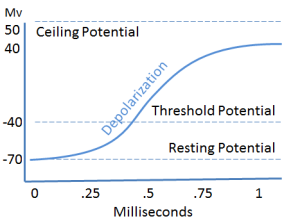 Resting Potential
Resting Potential
Neurons’ resting potential is about -70 millivolts; they are said to be polarized with respect to external fluids. At any given time, most synapses are at resting potential. Inhibitory negative impulses increase or hyperpolarize the negative electromotive potential to -90 millivolts or further. Depolarization (excitation) reaches threshold value at around -40 millivolts. This curve illustration shows the attack curve of the excitatory impulse that occurs in the first millisecond of a typical excitatory impulse. This rise in the electrical potential is followed by a fall called its “decay.” Action potential decay at any point in a nerve fiber is usually as rapid as its firing. Impulses last around one millisecond.
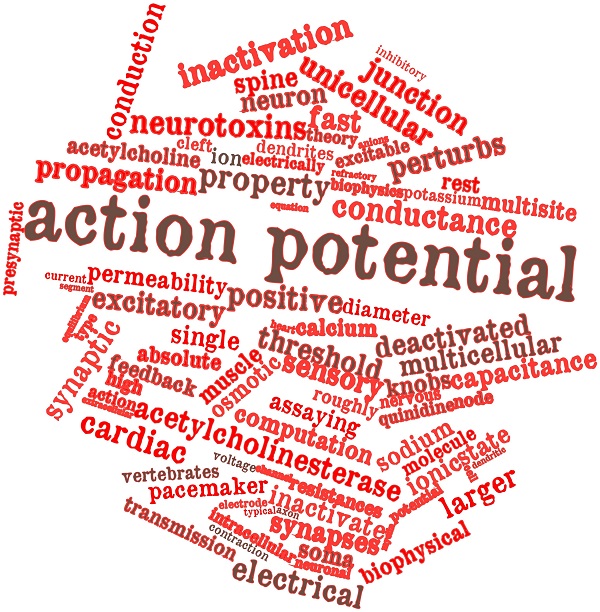
Exocytosis
When an impulse or spike arrives at a nerve ending, channels in the presynaptic membrane open. Where synaptic vesicles are in contact, neurotransmitter is released from the vesicles through the channel. Molecules of neurotransmitter chemical traverse the gap and bind with receptor molecules attached to the  postsynaptic membrane. This causes channels in the target nerve’s fiber to open up, permitting the influx of positively charged sodium ions that are more concentrated outside the cell membrane than inside. The sodium residing in the cleft is the agent of excitation while other chemicals provide inhibition. The amount of neurotransmitter chemical released governs the aperture of the channels, thereby indirectly determining the intensity of the impulse transmitted.
postsynaptic membrane. This causes channels in the target nerve’s fiber to open up, permitting the influx of positively charged sodium ions that are more concentrated outside the cell membrane than inside. The sodium residing in the cleft is the agent of excitation while other chemicals provide inhibition. The amount of neurotransmitter chemical released governs the aperture of the channels, thereby indirectly determining the intensity of the impulse transmitted.
Receptor channels are normally closed but they temporarily open when under the influence of neurotransmitters.The illustration at right shows a Closed Channel and an Open Channel. I like the way this video shows the process: Click here to see exocytosis. Here’s another that has nice subtitles.
The illustration below represents the shape of many impulses in the brain. Of course, human cognition involves the senses as well and possibly other nerve activities outside the brain, and those impulses may look very different as well. But this curve illustration is a good example to compare with computational models. The flow of electricity in a computer and its chips bears almost no resemblance to brain, neuron and synapse function or architecture. so as I seek to develop a model, I focus on the capabilities and the outcomes. But the mechanisms are important to the modeling assumptions I will be presenting in the next few posts.
Channels
Nerve impulses, triggered by changes in potential propagated through incoming synapses, accumulate at the place the axon leaves the soma. Channels in neuron membranes have gates at one or both ends that, when open, permit natural diffusion of chemicals through the membrane. Whether the voltage is positive or negative, this diffusion brings the voltage difference across the axon membrane closer to zero. Ahead of the affected region, channels in the membrane open and let sodium ions pour into the axon, creating a domino effect. Impulses travel from dendrites through the soma and down the axon to synapses. Stevens on the Flow of Sodium and Potassium Ions “The process is self-reinforcing: the flow of sodium ions through the membrane opens more channels and makes it easier for other ions to follow. The sodium ions that enter change the internal potential of the membrane from negative to positive. Soon after the sodium channels open, they close, and another group of channels open that let potassium ions flow out. This outflow restores the voltage inside the axon to its resting value of -70 millivolts” [Stevens, 1989, p. 7].
Ion Pumps
After the impulses have traveled down the axon to synapses, the resting potential of neurons and the proper disequilibrium of chemical molecular distribution is then restored by the action of ion pumps (see illustration). The restoration process affects potential latency and the permeability of membranes around the synaptic cleft. Thus, even when the level of excitation transmitted from one cell to the next is of limited intensity or duration, there is a time envelope during disequilibrium restoration in which membranes are more susceptible to electro-chemical influence. This is particularly useful in the muscular system because of our need to affect prolonged contractions for tasks like holding, carrying, and pushing. This will be discussed in more detail later.
In the context of cybernetics, the maintenance function provided by ion pumps presents interesting questions for modeling. For example, in an artificial neural network, how would the gradual return of a node (neuron) to resting potential be represented? Clearly, that process is opposed to the immediate spike and return with a short refraction period evidenced in many types of action potentials. Again, we will revisit this later.
Inhibition
Without cooling influences on the flow of excitatory impulses, the brain could run amok. Emergent consciousness and understanding want to get to solutions quickly, whether in interpreting sensory input or symbolic language. Inhibitory impulses prevent us from pursuing crazy ideas or spending so much time processing low-probability interpretations that we never arrive at understanding. “Inhibition or inhibitory control is the ability to inhibit or control impulsive (or automatic) responses, and create responses by using attention and reasoning. This cognitive ability is one of our Executive Functions and contributes to anticipation, planning, and goal setting. Inhibition or inhibitory control blocks behaviors and stops inappropriate automatic reactions, changing one response for a better, more thought-out response adapted to the situation” (Cognifit). Computer models that accurately reflect brain activity must provide both excitatory and inhibitory impulse flows.
The Entire Process
Mr. Beal’s Biology page has a great illustration of the chemical process cycle of an action potential:
The use of the term “undershoot” here and “overshoot” in other places should not be considered a contradiction. This beautiful illustration from Mr. Beals biology page helps in understanding the process. In upcoming posts – a little more detail on the curve itself.
| Click below to look in each Understanding Context section |
|---|





